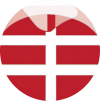The Danish island of Nyord is located north of the island of Mön on the Steger Bay, not far from the Ulvshale peninsula and, with its short length of around 3.8 kilometers and its width of around 2.3 kilometers, has only about 50 inhabitants and an area of just under five Square kilometers, which is mainly covered in the east by salt marshes and marshland.
On the southern coast in Nyord there is a small, cozy boat harbor that was built 120 years ago when the island’s inhabitants built it as a home port for their sailing ships, fishing fleet and as a base for the pilotage service, which was important at the time. In the past, pilotage was the main source of income for the islanders alongside agriculture. Even today, the pilot’s house stands at the highest point on the island and can be easily reached on foot. Meanwhile, the port still serves as a fishing port for the local fishermen. Whereby this is quite cozy: fishing huts, stacked net posts and hanging fishing nets determine the picturesque picture here.
Until 1968 Nyord could only be reached by ship. Since then, the small island has been connected to Mön by a bridge. The front part of Nyord consists of rather damp, sometimes even wet meadows, on which cows graze and numerous different species of birds breed. Thanks to the isolation, the island was largely spared the ultramodern developments of our fast-paced times, so that the only place (also known as â € œNyordâ €) has remained a wonderfully cozy village with thatched houses from the 19th century to this day. Furthermore, the countless peaceful gardens full of poppies, roses, irises and lupins underline the incomparable atmosphere of this rural idyll. What makes this quiet here even more perfect is the strict driving ban for cars, because visitors usually have to park their vehicle outside of the village.
Under no circumstances can the village of Nyord be called a museum village and the gardens and houses are of course not so easy for visitors to the island to enter. But there are two charming little museums here that are definitely worth a visit: One is right in front of the village in a restored barn, the other at the entrance to the village. The old pilot town is also very well known for its octagonal church. It is also worth visiting the famous glass artist Runa or the village shop â € œNoorbohandelenâ €, where you can even try different types of whiskey and selected regional products such as mustard produced on Nyord and spirits are available in loose weights. The old farm restaurant â € œLolles Gaardâ €, which mainly uses local food in the kitchen and always has the finest delicacies ready for visitors to the island, provides true culinary delights.
As exceptionally idyllic as the village of Nyord is, the landscape around the village is just as extraordinary: The very pretty hillside location of the village is particularly worth mentioning. However, only the western part of the island can be used for agricultural cultivation, the east side of the island consists of extensive salt meadows with particularly species-rich plant life, which take up around two thirds of the entire island area. Together with the meadow areas of Ulvshale on the other side of the dam, an area of more than 500 hectares is under nature protection, which is one of the most important shallow water zones in all of Europe, as it is on a main flight route for migratory marsh and waders.
Especially for bird lovers, the island of Nyord offers the most beautiful opportunities to watch the countless migratory birds. An excellent view can be enjoyed from the Hyldevang Nature Center, which is located in the middle of the island. Bird lovers will not only discover sea birds, mudflats or birds of prey here, but also a number of migratory birds that stop on the island with its internationally important bird life. The observation tower also provides unforgettable views over the extensive meadows and even over the areas of Mön. The nature center has a large viewing platform, a few picnic benches, a playground and a wonderful garden for the senses.
